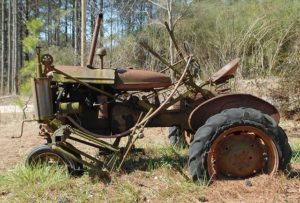Retirement, the First Law of Physics, and the Iron Oxide Risk

Isaac Newton was a great physicist. Maybe not by today’s standards, but he helped us move forward with some pretty big leaps back in his day. Like (1) deciphering gravity; (2) inventing calculus; (3) building the telescope.
He also introduced the “First Law of Physics”.
This law is sometimes referred to as the law of inertia and is often stated as:
An object at rest stays at rest and an object in motion stays in motion with the same speed and in the same direction unless acted upon by an unbalanced force.
The word “object” in the law would seem to reference a solid, physical object – like a rock, a car, a rocket ship, a human body.
I’ll bet, however, that you know a mind or two at rest that is impervious to any opposing view or unbalancing force. I’ve encountered a few. There seems to be quite a collection gathering daily along the Potomac.
Isaac’s law pits inertia against action.
My body and mind seem to favor the inertia and resist the action. Like daily. It’s so much easier, it seems, to be comfortable, inert.
Be honest. You’ve been there.
I found myself thinking about the phases – or portals if you will – that we pass through in life and the “unbalancing forces” that move us through those portals, countering our tendency to be a perpetual “object at rest”. Parents, peers, professors, cultural expectations/pressures. Sometimes it takes a crisis or a calamity before an inertia-beset mind and body get moving.
Psychologists and marketers have brought us to where we now have seven life portals (P.S. 150 years ago, we had two: childhood and adulthood). Each portal (newborn – infancy – childhood – adolescence – young adult – middle age – old age) has inertia and an unbalancing force to counter the inertia.

Aren’t you grateful you had some unbalancing forces in your life that moved you off your inertia-inclined butt at each phase?
Intentional inertia
 I’m grateful I got moved off each portal. I just regret that the unbalancing forces didn’t come along sooner and more forcefully, especially in the later stages. But that’s a sob story for another article. It will have “intentional inertia” in the title.
I’m grateful I got moved off each portal. I just regret that the unbalancing forces didn’t come along sooner and more forcefully, especially in the later stages. But that’s a sob story for another article. It will have “intentional inertia” in the title.
Speaking of “intentional inertia”, as I scanned those life portals reminiscing on who and what the unbalancing forces were at each phase, it struck me that there is a phase where, culturally, we work somewhat feverishly to establish intentional inertia. Between portal six and seven, middle age and old age.
It’s called (drum roll) – retirement.
Think about it. We’re taking a body in motion, some fast, some slow, some half-fast (sorry – old, tired joke) and we’re suggesting a return to inertia, or at least a measure of it.
We’re entitled to it, we’re told. We’ve succumbed enough to the “unbalancing forces” in the earlier portals. Time to stiff-arm those and experience a little or a lot of good ‘ol inertia.
Funny thing about inertia. This may sound crazy, but my screwy mind went to my days spent on my grandfather’s and uncle’s farms. Both farms had lots of “retired” farm equipment – tractors, combines, plows, various farm implements. What did they do with them? There was no convenient way to “recycle” in those days so they became inert, often at the spot where they quit working.

From there, nature’s payoff for inertia took over – rust. Useless, inert, just taking up space and using up oxygen and moisture to form iron oxide. It’s the sort of “farm junk” that you will see as you drive by any small farm in America.
I know some retirees that remind me of one of my Uncle Ray’s old retired Farmall tractors. Taking up space, using oxygen, immobile and inert.
I’ll bet you know some too.
Between portal six and seven, which I refer to as our “third age”, there is great opportunity for self-imposed inertia. 
Our financial planning industry, founded by insurance salespeople a half-century ago, has been hugely successful in convincing us that it’s a time to “wind down”, a time for a “landing”.
No more “take-offs” – you’re done with that.
How could a $60.4 billion industry that’s growing at a 5% pace annually with over 300,000 financial advisors possibly be dispensing bad advice?
Well, it’s really in the eye of the beholder. It’s easy to think inertia when you are burned out doing something you didn’t fully enjoy so you could accumulate the cash to maybe do what you really wanted to do all along and then discover out you don’t have the motivation or the energy to do it. All the while, your financial advisor is in your ear convincing you that there are “golden years” ahead and you deserve them.
Forget this striving business, they say – you’ve paid your dues.
I know it’s a hard truth, but you’ve been relinquishing a good chunk of your net worth to get a lesson in how to form iron oxide.
 One-hundred-fifty years ago, we had no one telling us that we’ve earned the right to become a body at rest. The incentive to keep moving was called survival and work was the engine. We flipped all that upside down with the Industrial Revolution and intensified the incentive to become inert as we’ve moved through an evolving revolution in the way we work and live.
One-hundred-fifty years ago, we had no one telling us that we’ve earned the right to become a body at rest. The incentive to keep moving was called survival and work was the engine. We flipped all that upside down with the Industrial Revolution and intensified the incentive to become inert as we’ve moved through an evolving revolution in the way we work and live.
The word “work” for a mid-to-late-lifer seems to have become a bad word. Something to get away from because, well, just because that’s the way it’s now done. We’ve been hearing that mantra for six or seven decades so it’s not surprising that it’s not going to be dislodged any time soon.
But I see a glimmer of rational thought emerging. There are those amongst the pre-boomer, boomer, and early GenX’ers that are questioning this iron oxide option.
- Maybe they’ve seen too many human equivalents to my uncle’s rusted Farmall.
- Maybe there is a growing realization that 65 doesn’t mean “done”.
- Maybe more of us are through buying the outdated bull**** from a “drug it or cut-it-out” medical community that says cellular senescence is automatic and that we should “learn to live with it.”
- Maybe we’ve seen enough Warren Buffetts, William Shatners and other high energy octogenarian and nonagenarian types that are still kicking butt to convince us that unretirement/non-retirement has merit.
- Maybe we are giving up hope that government and corporations will come to their senses about their disrespect for mid- and late-lifers and have decided to do our own thing.
- Maybe we’ve finally learned that ageism starts with us, with how we think and talk about ourselves and how we tolerate how others think and talk about us.
- Maybe we are finally acknowledging that continuing to deploy our accumulated talents, skills, and experiences into the third age will overcome the deterioration that our culture expects us to experience.
I’m not prepared to call it a full-on revolution yet, but something’s fermenting. If you’ve read this far, you might be part of that fermentation. I hope so.
I hope you literally get pi**** off about the prevailing negative cultural attitudes toward those beyond 55 or 60 and mount your own personal campaign against the forces that encourage us to succumb to Uncle Isaac’s “First Law of Physics”.
Let me know what you think about all this with a comment below. Also, you can subscribe to our weekly newsletter at www.makeagingwork.com and receive a free e-book “Achieving Your Full-life Potential” as a thank you.





Human do rust and it is called arthritis. Arthritis occurs by joints not moving, restricting the amount of synovial fluid, and our inflammatory diet. Synovial fluid is like a WD 40 that naturally secreted into our joints. According to the medical dictionary, arthritis is not a disease. Osteoarthritis is a tightening of the joints due to lack of use. Rheumatoid arthritis is autoimmune disease. There is actually a portals now in the old portal. 65-75 is the young old; 75-85 is the old; and 85+ is the old old. 85+ is the fastest growing age segment in the country. Hope this helps. Great article!!
Hi Gary, much of my early development happened on an Allis Chalmers WC, a Ford P-9 and a John Deer A. Powerful good stuff, hard work and I would not trade it for anything. Those old farmers knew work was a part of life from early on to the end and the usually only slowed down when they had too. They saw not merit in retirement as they were fulfilled by their life work.. Retirement seemed like quitting before the finish line and they didn’t quit. Mission and life-long purpose fueled them and we are poorer as we lose touch with their values, principles and ethics.Today we have to reboot, change and modify our mission several times or more to get to the finish line, but sitting and quitting isn’t an option.
I believe you are way too easy on the marketers who keep finding new ways to make money off the backs of people selling costly products that don’t fit, that we really don’y need, but folks are too trapped by herd mentality to step back and see they are being had. A great third phase is a very “do it yourself phase” (with a bunch of help from our friends). We increasingly don’t buy the bullshit pitched to the masses and we find our own way through, just like to old framers I grew up with.
Keep going your work helps us all.
Roger, can I steal the “sitting and quitting” phrase? I like it. I appreciate that we seem to have come from similar gritty backgrounds. Nothing like a whole day breathing in diesel or gas fume sitting on a Farmall going round-and-round-and-round. And with no MP-3 player. How did we ever get through it? Thanks for your kind comments.
I just couldn’t depart your website prior to suggesting that I actually enjoyed the standard information a person provide for your visitors? Is going to be back often to check up on new posts
To the makeagingwork.com webmaster, Your posts are always well-cited and reliable.
Hi makeagingwork.com admin, Nice post!
To the makeagingwork.com webmaster, Your posts are always well-referenced and credible.
Hi makeagingwork.com administrator, Great post!
To the makeagingwork.com webmaster, You always provide valuable feedback and suggestions.
Hello makeagingwork.com owner, Your posts are always well-structured and logical.
Hi makeagingwork.com webmaster, Great job!
Dear makeagingwork.com owner, Your posts are always a great source of information.
Hello makeagingwork.com admin, Your posts are always on topic and relevant.
To the makeagingwork.com administrator, Good work!
Dear makeagingwork.com owner, Your posts are always well-cited and reliable.
Hi makeagingwork.com administrator, Keep the good content coming!
Dear makeagingwork.com owner, Your posts are always well presented.